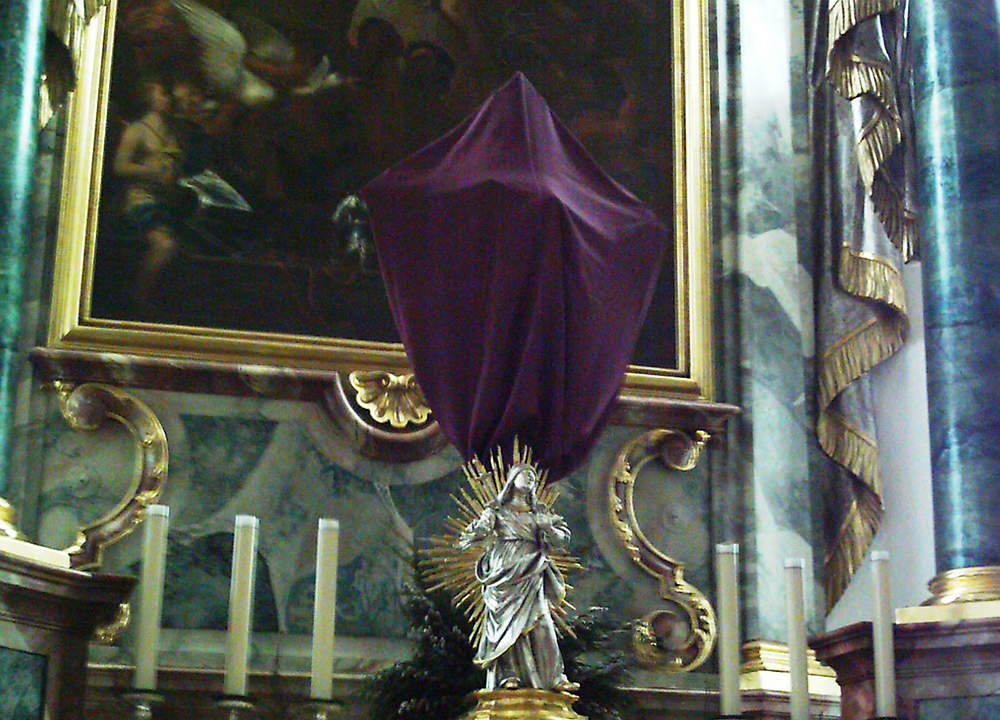- Feb 5, 2002
- 166,654
- 56,276
- Country
- United States
- Faith
- Catholic
- Marital Status
- Married
- Politics
- US-Others
The Fifth Sunday of Lent means one thing to me: It’s time to veil the statues.
The pastor at my first parish brought back the practice of veiling statues at St. Pius. The old custom had fallen out there, as it had in many parishes. But in 2011, the new English translation of the Roman Missal prescribed: “In the Dioceses of the United States, the practice of covering crosses and images throughout the church from this Sunday may be observed.”
The sanctuary in St. Pius Church is dominated by an immense crucifix. Parish teens would scale the marble reredos and carefully drape the cross in a giant sail of violet fabric. It produced a haunting effect. The graceful statues throughout the church became silent, ghostly sentinels, awaiting the Easter liberation of their shrouds.
Customarily, we veil holy things. We veil tabernacles (a nod to the veil of the holy of holies in the Jerusalem Temple, Ex 26:31-33), and we veil chalices. But the veils also focus us, simplifying our ornate churches, drawing our attention to focus on the readings and prepare our senses to experience Easter.
But on this Sunday, which opens the heightened period of anticipation before the Paschal Triduum known as Passiontide, the veils, it seems to me, are more symbolic of death than anything else.
Continued below.

 www.oursundayvisitor.com
www.oursundayvisitor.com
The pastor at my first parish brought back the practice of veiling statues at St. Pius. The old custom had fallen out there, as it had in many parishes. But in 2011, the new English translation of the Roman Missal prescribed: “In the Dioceses of the United States, the practice of covering crosses and images throughout the church from this Sunday may be observed.”
The sanctuary in St. Pius Church is dominated by an immense crucifix. Parish teens would scale the marble reredos and carefully drape the cross in a giant sail of violet fabric. It produced a haunting effect. The graceful statues throughout the church became silent, ghostly sentinels, awaiting the Easter liberation of their shrouds.
Customarily, we veil holy things. We veil tabernacles (a nod to the veil of the holy of holies in the Jerusalem Temple, Ex 26:31-33), and we veil chalices. But the veils also focus us, simplifying our ornate churches, drawing our attention to focus on the readings and prepare our senses to experience Easter.
But on this Sunday, which opens the heightened period of anticipation before the Paschal Triduum known as Passiontide, the veils, it seems to me, are more symbolic of death than anything else.
Continued below.

A provocative symbol, the veils actually mean death
As we continue on in our Lenten Journey, Father Patrick Briscoe, editor of Our Sunday Visitor, anticipates the Fifth Sunday of Lent for a very particular reason: “The Fifth Sunday of Lent means one thing to me: It’s time to veil the statues.” He continues: “Customarily, we veil holy things. We...
 www.oursundayvisitor.com
www.oursundayvisitor.com
